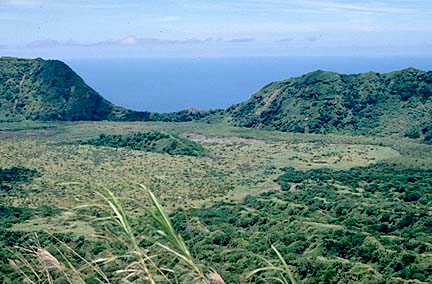
ASSOCIATED PRESS
A previously dormant volcano on the tiny island of Anatahan near Saipan erupted May 11, sending smoke and ash six miles high. The eruption on the North Pacific island, where people have lived for short periods, has raised awareness of volcanic danger in the U.S. Commonwealth of the Northern Mariana Islands, nearly 4,000 miles west of Hawaii.Eruption near
Saipan intrigues
isle scientistsThe giant cloud of ash over
the remote island provides a test
for modern satellite technology
Hawaii scientists are monitoring the first eruption in historical times of Anatahan Volcano about 200 miles north of Guam in the Northern Mariana Islands.
The explosive eruption May 11 (May 10, Hawaii time) spewed a towering column of ash and gas more than 33,000 feet above sea level, according to information compiled by Frank Trusdell, of the Hawaiian Volcano Observatory.
Juan Babauta, governor of the Commonwealth of the Northern Mariana Islands, which include Saipan, declared a state emergency after the eruption started, and barred most boats and planes from within 30 miles of Anatahan.
A government spokesman said a team of scientists hopes to get on the island today to take measurements.
The ash was blown about 1,000 miles to the west by the prevailing winds.
"An immediate concern that was felt far beyond the western Pacific was the potential for the tiny abrasive ash fragments to damage aircraft passing nearby and downwind from the volcano," HVO reported.
The Federal Aviation Administration is monitoring the ash, which is at a fairly low level now, said Tweet Coleman, FAA Pacific representative.
She said a significant meteorological message, or "sigmet," has been issued warning airplanes of significant ash from the surface to 10,000 feet.
COURTESY OF SCOTT ROWLAND
A swallow lake filled the crater before the eruption.
Commercial airplanes that fly at higher altitudes between Hawaii and the Philippines or Far East are not affected, she said, but small airplanes fly out of Guam and Saipan at low altitudes.
"Volcanic ash is very, very dangerous," she said. "It plays havoc on the engines of an airplane."
University of Hawaii-Manoa researcher Scott Rowland said the ash bloom was "pretty impressive" when the eruption started.
"You would not have wanted to fly through it." And even though it is lower, Rowland said, "You still wouldn't want to fly through it."
Rowland and fellow UH researcher Luke Flynn are working with Trusdell on observations of the erupting volcano.
Flynn receives information daily that he is sending to Trusdell from the Geostationary Operational Environmental Satellite and instruments that monitor the earth's surface from two NASA satellites.
COURTESY OF SCOTT ROWLAND
U.S. Geological Survey volcanologist Jack Lockwood collected water samples from Anatahan's shallow lake in 1990.Volcanic eruptions can be tracked around the globe with data from the Moderate Resolution Imaging Spectroradiometer instruments, he said.
"We were able actually to pinpoint where the hot spot is on the island (Anatahan)," which is about 5.6 miles long and 2 miles wide, Flynn said.
The Anatahan eruption was first spotted by infrared satellite images monitored by the National Weather Service on Guam and then by a team of geologists from Washington University in St. Louis that had been on the island just days before.
"It was the most amazing thing I've ever seen in my life," said Sara Pozgay, a Washington University graduate student on the team. She described the cloud formed by the volcano as full of lightning created by static electricity built up from particles in the cloud.
The eruption triggered concern over the lack of a warning system, which scientists said should put local and federal officials on alert.
A seismic monitoring system set up by the commonwealth is not functioning because of a lack of funds to maintain it, according to technician Juan Camacho, of the islands' Emergency Management Office.
COURTESY OF SCOTT ROWLAND
A view of the island from the crater rim. Said University of Hawaii-Manoa researcher Scott Rowland, "You could tell it was a relatively young volcano. Deposits were not very vegetated or very weathered. It must have erupted sometime in the previous 1,000 years or so, but that was a guess."
Rowland said he "was fortunate to tag along" with Jack Lockwood, U.S. Geological Survey volcanologist, on a trip to Anatahan in 1990 "when it first showed signs of unrest."
He returned alone about a month and a half later to follow up on their work, he said.
He said they saw "bubbling muddy hot springs" in one of the craters, but villagers did not go to that area often, "so we couldn't tell, based on the activity we saw and speaking to people, whether that was unusual. ...
"You could tell it was a relatively young volcano. Deposits were not very vegetated or very weathered. It must have erupted sometime in the previous 1,000 years or so, but that was a guess."
HVO said that in 1990 the geologists "discovered abundant evidence of ancient explosive eruptions that sent fast-moving flows of hot ash and rocks across the island," so they were not surprised by the recent eruption.
Most residents were evacuated in 1990 because of seismic activity and increased gas emissions inside the crater, Rowland said.
Some may have returned, but the village was located as far from the erupting crater as possible, he said.
Lockwood has retired and Trusdell has taken over observations for Anatahan and other non-Hawaii volcanoes, Rowland said.
The HVO scientists work with the Emergency Management Office of the Commonwealth of the Northern Mariana Islands, which has sent technicians to Hawaii for training, he said.
Since 1990, UH-Manoa, UH-Hilo and HVO scientists have run a six-week summer training program, the Center for Study of Active Volcanism, for volcanologists from developing countries, particularly around the Pacific Rim, he said.
The Associated Press contributed to this report.



